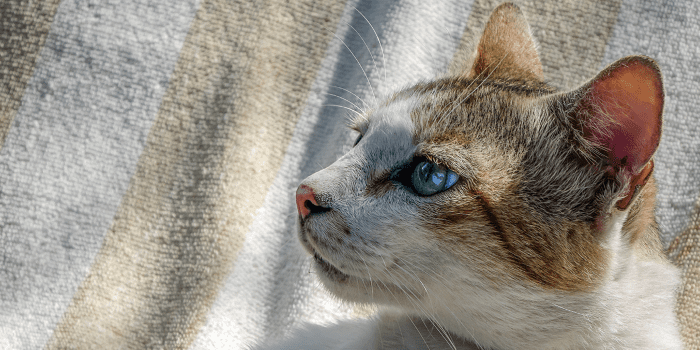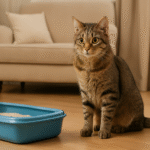Certainly one of the most devastating diseases affecting cat populations around the world is feline leukemia. The feline leukemia virus belongs to a group of infectious agents known as retroviruses, and it shares some characteristics with the human AIDS virus. It can occur by itself, or in combination with the feline immunodeficiency virus (FIV), a deadly AIDS-like virus that in itself has been spreading at an alarming rate in cats in recent years.
Like the human AIDS virus, both of these feline diseases wreak havoc on the cat’s immune system, pre- disposing it to a wide variety of infectious diseases and to cancer.
The feline leukemia virus can be transmitted via all bodily excretions from an infected cat. Infected queens can transmit the disease to their offspring through the placenta prior to birth or through the milk during lactation. As a result, even newborn kittens can test positive for this disease. For other cats, close contact is required for effective transmission.
As a result, feline leukemia is most prevalent in multiple-cat households and catteries. Interestingly, cats over 1 year of age that have otherwise healthy immune systems seem to develop a natural resistance to the feline leukemia virus.
Because of the ability of the feline leukemia virus to suppress the cat’s immune system, infected felines are prone to cancer (especially lymphosarcoma and leukemia), anemia, kidney disease, and a wide variety of secondary infections such as feline infectious peritonitis, hemobartonellosis, cryptococcosis, and upper respiratory viruses. Pregnant queens might abort their kittens, or give birth to weak, unthrifty off- spring that die soon after birth.
Even cats suffering from seemingly innocent lesions on their skin and mucous membranes could actually be suffering from an underlying infection with feline leukemia. Finally, in some affected individuals, the only apparent signs might be lethargy, weight loss, and/or chronic gingivitis.
Diagnosis of feline leukemia is accomplished by a simple test that can be performed in a veterinarian’s office. Tears and saliva can be used for initial screening purposes, but for definitive answers, a blood test should be performed.
Once bone marrow penetration has occurred, permanent infection is likely, and the majority of these cats will become active carriers and shedders of the disease. FeLV has the ability to incorporate itself into the genetic material within host cells and remain dormant (not causing dis- ease) for long periods of time.
As a result, an infected cat might not show any adverse signs for years. However, if the immune system becomes stressed in any way, the FeLV will become active, and clinical signs appear. In general, cats with permanent FeLV infections usually succumb to FeLV-related disease within 3 to 5 years after initial exposure.
Currently, there is no cure for the FeLV virus. Treatment is directed at relieving any clinical signs seen and eliminating secondary infections or managing cancerous conditions present. Unfortunately, however, recurrences of such diseases are common after treatment. Many experimental agents, such as interferon, antiviral drugs, and medications designed to modulate the immune system, have been employed in an attempt to eliminate the feline leukemia virus itself. Unfortunately, to date, these have met with limited results. Bone marrow transplant,
although helpful in some experimental instances, is not as yet a proven or practical means of treatment. The bottom line: The best treatment for feline leukemia is prevention!
Vaccines that can help protect a pet against this deadly disease are available from veterinarians. Kittens in high-risk households can be vaccinated as early as 9 weeks of age. These kittens should receive two initial boosters 3 weeks apart.
Prior to receiving the vaccine, all kittens should be tested for the leukemia virus. While such testing is not mandatory before the vaccine is given, it is always a good idea to prevent a false sense of security in an owner’s mind. Remember: Because they can be born with this disease, even kittens that have no other history of exposure should be tested.
There are other control measures that you can implement to protect cats from FeLV. Testing all new cats before introducing them into a household is one. In addition, when boarding a feline or taking one to cat shows, be certain that the facility or event requires that all cats be tested free of leukemia and vaccinated prior to admission. Finally, keeping a cat indoors at night and, if it is a male, having it neutered, will help reduce potential interactions with neighborhood carriers of the disease.
A question frequently asked concerning a cat that has tested positive for FeLV is “Is feline leukemia transmissible to humans?” To date, no antibodies to FeLV have ever been found in human individuals in high exposure–risk groups such as veterinarians, cat breeders, and lab- oratory handlers. In addition, the incidence of cancer in humans seems to show no correlation with exposure or nonexposure to FeLV- positive cats.
However, the ultimate decision governing whether a FeLV-positive cat is to be kept in a household rests on the cat owner. Many veterinarians and researchers do recommend segregating children, pregnant women, the elderly, and immunocompromised persons from cats that have FeLV, primarily because of the other zoonotic organisms that these immune-depressed cats may be harboring.
Certainly other cats within the household, even if fully vaccinated, are at risk of contracting the disease from an infected cat. However, in those situations in which none of the above apply, the difficult decision on whether to keep a FeLV-positive feline is a personal one, and should be influenced by an owner’s individual feelings on the matter and the cat’s overall health status.


